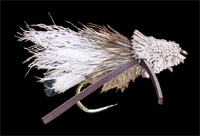In August 1990, a tying vise, an inkling of a concept and a six pack of beer brought everything together and the Turck Tarantula was born. At it’s public debut, in September 1990, it took first place honors at the Jackson Hole One Fly Event in the able hands of George Anderson. In the intervening years, it has become one of the most popular fly patterns in Jackson Hole and is being discovered and used by more and more fly fishers throughout the country and world.

Some Thoughts On Fly Design
I’m often asked where I got the idea for the Tarantula. Like most patterns I’ve designed, the initial idea was derived from a perceived need. In other words, there was a problem to be solved and I needed to develop a new fly pattern to help solve that problem. In the summer of 1990 my fishing clients had been having good luck with a pattern you may be familiar with called the Madame X. Despite it’s effectiveness, it had a number of shortcomings which I felt could be improved upon. The commercially tied versions of the Madame X which we were using didn’t float very well and were sometimes difficult to see in the fast water streams which frequent the Jackson Hole area. What I was looking for was a pattern which maintained the Madame X’s effectiveness, but would float better and be easier to see. Any other improvements would be considered a bonus. In the end, the only feature of the Madame X to be retained by the Tarantula were the rubber legs, everything else was changed.
The Components
The visibility problem was solved by replacing the deer hair wing of the Madame X with white calftail. Sometimes I’ll also top the wing with a few strands of krystal flash. Floatation was increased by using a spun clipped deer hair head as well as dubbing the body with natural fur. The natural fur was also much more realistic than the thread body found on the Madame X (at least the commercial versions). Finally, pheasant tippets were used for the tail, which added just a touch of flash. Trout, as we all know, view a fly from below as it is backlit by the sun. From this vantage point, the backlighting effect of the sun on a natural insect creates a “halo” effect around the perimeter of the natural. Light passes through the translucent outer edge of the fly’s body, but the same light is blocked by the center of the body, which is thicker. Natural fur does an admirable job of imitating this “halo” effect because it’s fuzzy surface allows the passage of light around the fringes of the body. Thread, on the other hand, doesn’t allow for any passage of light and appears as a solid block of material (like a stick or twig would appear). The passage of light through an insects body and the resultant “halo” (depending on the actual thickness of the insect) has other important and surprising ramifications which I’ll get into later.

Fly Tying and Testing
Once the components of the fly were decided upon, I still had to learn how to tie the darn thing. That turned out to be the hard part. As far as I know, the Tarantula was the first trout pattern to combine rubber legs with a spun clipped deer hair head. This presented quite a problem for the fly tyer because it can be very difficult to trim the deer hair head without also snipping off the rubber legs. After much trial and error, most tying problems were surmounted with, well, trial and error. To be more precise, I developed some techniques which prevented the accidental clipping of rubber legs as well as some new tools to help speed up the tying of a dreadfully time consuming pattern. The Tarantula will never be an easy (fast) fly to tie, but the new tools did make commercial production feasible. Finally, some research and development (in other words, fishing) was needed, which goes on to this day. R & D helps answer such questions as: 1) Under what conditions (fast water, slow water, cloudy, sunny etc.) is the fly most effective, 2) Which hatches is it most suitable for?, 3) Which techniques work best?, 4) What possible variations are there and when should they be used?, and so on. The answers to these questions vary from year to year. Rivers change. Lakes change. People change. What does it all mean? I don’t know… guess it requires more R & D!
